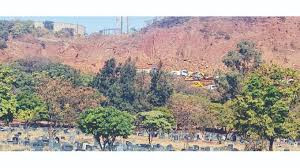
A POTENTIALLY disastrous situation is unfolding in Harare’s Warren Park area, where Harare City Council (HCC) is pushing forward with plans to convert former gravel pits into residential stands.
An investigation by Truth Diggers has revealed that engineers warn the ground is unstable and unsuitable for construction.
Truth Diggers is an investigative arm of Alpha Media Holdings (AMH), publishers of The Standard, NewsDay, Southern Eye and the Zimbabwe Independent as well as operating online radio and TV station, HStv.
The pits, dug years ago for gravel extraction, stretch as deep as 80 meters.
Despite remaining untouched for years, the HCC plans to fill them and create residential stands for over 60 families.
“We hope to finish levelling this area in three months,” said Ronias Matenese, an engineer working on the project.
“However, we cannot allow any form of construction until after four to five years. The ground won’t be stable enough to hold any infrastructure. The structures will collapse.”
Although he acknowledged the city’s dire need for residential space, Matenese emphasised the need for proper compacting and stabilising materials to ensure safety.
- Harare cancels Pomona waste deal
- Devolution gains remain a mirage
- Harare cancels Pomona waste deal
- Pomona saga: Harare handed shock US$750k ‘garbage’ bill
Keep Reading
“I understand so many people have been on the waiting list, so the council is trying to clear the backlog by creating a space where they could build residential stands,” he said.
“We are also going to put roads and other facilities. So we will try to squeeze this place and it will accommodate roughly 60 families or more. We will get the final design after leveling this area and filling up the deep pits.
“That is when we can have an exact figure. We started this project last year and the budget is about US$1,2 million.”
One of the councillors in Warren Park confirmed that the first pit to be reclaimed was 45 metres deep, the second 80 metres and the last one, which was currently being filled, was 15 metres deep.
He also noted the long-standing danger posed by the pits, which have been a source of fear to the community.
“We had budgeted US$50 000 for the reclamation of these pits, but the money was not enough. These pits that are being reclaimed were those that were being dug by Harare City Council to get gravel for road construction,” the councilor said.
“The pits had become a danger to children. So far, three children died after falling into those pits while several others were injured in the past six years. So we now want to fix this.”
Efforts to get a comment from mayor Jacob Mafume on the Warren Park pits were fruitless as his number went unanswered up to the time of going to print.
Harare City Council’s decision on the Warren Park pits is part of a broader effort to address the city’s housing shortage.
Recently, Mafume announced plans to transform neglected hills in Warren Park into a vibrant hub featuring residential areas, shopping centres and essential facilities.
He said the city intended to create over 500 residential stands as part of the project aimed at addressing the growing housing demand in the capital.
The rehabilitation of the area, estimated to cost between US$3 million to US$5 million, will be a comprehensive effort to not only improve the landscape, but also enhance economic activities in the area.
Many residents of Warren Park are, however, worried that the rush to provide housing would result in more lives being lost and homes destroyed.
While some acknowledge the urgent need for more residential areas, they believed the safety risks far outweighed any short-term benefits.
Tinashe Munatswa, a resident, said the area had been viewed as prime land for new housing developments, but the rush to provide homes was being weighed against the long-term risks.
“The city’s housing crisis is undeniable, but what good is it to put up homes that might collapse in a few years? You are not solving the problem, you are creating a bigger one,” Munatswa said.
Another resident, who has lived in the area for over 20 years, also expressed concern over the decision.
“We have been waiting for housing for a long time, but this is not the way to solve the problem. The ground here is not stable. We have already seen children falling into these pits and getting hurt. What will happen when houses are built and they start sinking? It is a disaster waiting to happen,” the resident said.
His neighbour, Fadzai Chikosha, agreed, adding that the council’s priorities seemed misplaced.
“Instead of fixing the land properly first, they are rushing to put up houses. People are desperate, yes, but they deserve to live in safe homes. Right now, this place is unsafe,” she said.
Last year, Mafume said they only managed to allocate 56 housing stands in five months while its housing waiting list was ballooning, resulting in land barons taking advantage of desperate home-seekers.
Last month, a commission of inquiry looking into the Harare City Council affairs since 2017 to date heard that the local authority was at sixes and sevens over 5 000 illegal residential stands, most which were doled out in the run-up to past elections.
The commission said there was an alarming surge in land encroachments across various districts, revealing that 5 066 stands were being recommended for regularisation once the ministry approved their plans.
Appearing before the commission early this month, council’s housing principal officer Edgar Dzehonye said the city’s housing waiting list was now just a mere formality because of land invasions.
“We have had situations where we have people who invade council land and then council resolves to regularise those people,” he said at the commission.
The city’s housing waiting list stands at over 100 000.
Earlier this year, the council said it was crafting by-laws to provide for the criminalisation of land barons that are wreaking havoc in the capital, parcelling out land on wetlands to desperate home seekers.
Land barons, most of whom are linked to the ruling Zanu PF party, have been illegally selling council and State land to desperate home seekers.
Residents associations condemned the continued parcelling out of land on wetlands.
Harare Residents Trust director Precious Shumba said land barons were to blame.
“Flooding is predictable in wetlands and low-lying areas such as Budiriro,” Shumba said.
“With all that knowledge, corrupt people in both council and the government have been collaborating with land barons to allocate people residential stands on the wetlands and waterways without any consideration of the impacts of their actions.
“If you visit and interview some of the victims, they reveal that identified council officials have misled the City of Harare by collecting money from the land barons and promising the desperate home seekers that nothing will happen to them.”
At one time, Harare residents wrote to President Emmerson Mnangagwa asking that the Justice Tendai Uchena land commission report be published to expose officials involved in the illegal selling and parcelling of State and council land.
According to HRT, in terms of compliance with section 62 of the Constitution, on access to information held by public bodies, the government of Zimbabwe should make the Justice Uchena report public.










